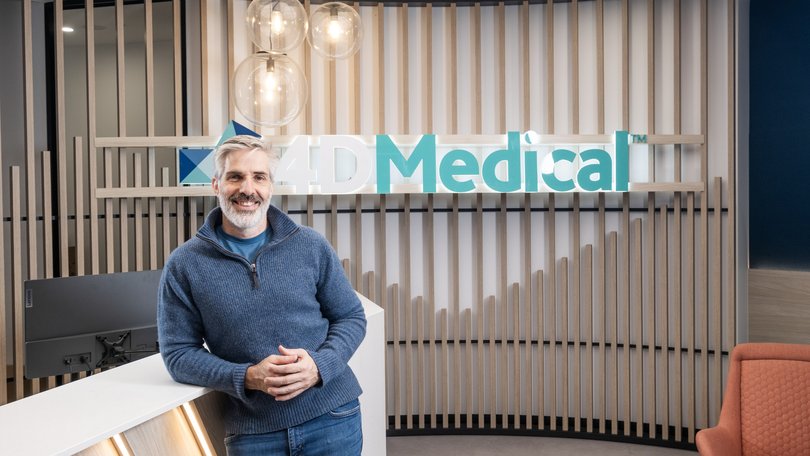4DMedical: Professor sold his house for a lung imaging dream and created a $1 billion ASX stock

Back in 2014, Professor Andres Fouras sold his Melbourne home and bet all his wealth on technology he believed could transform how the medical profession examines the human lung.
After years of middling progress and little traction with investors, his ASX-listed company, 4DMedical, rocketed 380 per cent to a $1 billion valuation last week.
Professor Fouras said his message about 4DMedical’s potential has always been the same, but the business turned from sleeper to skyrocket after a slew of positive news in September.
Sign up to The Nightly's newsletters.
Get the first look at the digital newspaper, curated daily stories and breaking headlines delivered to your inbox.
By continuing you agree to our Terms and Privacy Policy.“Our tech allows medical practitioners to see lungs breathing and moving in four-dimensional (4D) form, so air-flows and blood movements over time,” Professor Fouras said. “So, 4D’s software is a way to upgrade every CT (computer topography) scan on the planet from something that takes still pictures of your lungs to something that shows movement as a functional map.”
Green September
September’s share price surge is underpinned by a string of announcements, which suggest the company is gaining traction in its ambitions to sell the 4D imaging tech to doctors in the US and Australia.
On September 1, the company told investors the US healthcare regulator the Food and Drug Administration (FDA) has approved its CT:VQ imaging tech for use by doctors across North America.
“If we execute the opportunity it’ll be a phenomenal success for the company,” Professor Fouras said. “The product’s suitable for a range of patients across tumours, blood clots, emphysema, really any respiratory condition. The doctors most excited are the lung surgeons and interventional folks, as lung doctors and surgeons want to know everything before they cut, and what that means for their surgery.”
According to the research team at stockbroker Ord Minnett, the US regulator’s approval means 4DMedical’s CT:VQ software product could displace around 1 million traditional three-dimensional V/Q nuclear lung scans performed each year at a cost around $US1,150 per scan.
A current standard of care VQ scan includes a ventilation scan where the patient breathes a radioactive gas to check airflow, and a radioactive tracer injected into a patient’s bloodstream to assess blood flow.
Professor Fouras said the key advantage of his CT/VQ software is that because it is non-nuclear, it eliminates the need to inject radioactive dyes into patients’ bodies that may have adverse side effects.
“There’s doctors that want to see the blood flow, but they don’t want to risk the dye,” he said. “So they do the surgery without it, but we can help doctors make millions of better decisions for patients.”
Ord Minnett said 4D’s US regulatory clearance was supported by an extensive clinical validation package including head-to-head performance testing versus current standard of care SPECT (Single Photon Emission Computed Tomography) imaging, which is a nuclear imaging test that produces 3D images of organs and tissues.
Focus on cash flow
The ballooning mania around the stock on social media and in micro-cap investment circles took it from a closing price of 48 cents on August 28 to a high of $2.31 on September 8.
By Wednesday it had retreated to $1.63 to still put the company on a non-diluted market value of $765 million.
On July 31, ASX-listed blue-chip medical software business Pro Medicus revealed it had invested $10 million in 4DMedical when the shares fetched just 24 cents.
The news fuelled interest in Professor Fouras’ start-up given Pro Medicus has rocketed around 135 times in value from $2.21 per share in September 2015 to $300 per share this week.
Before July 31, 4DMedical’s shares had languished as investors worried the company was haemorrhaging cash, with a net loss of $30.1 million over the 12 months to June 30. During the same period sales grew 56 per cent to $5.8 million.
As of September 2, the company said it had cash on hand of $22.9 million, with another $22.7 million potentially available via the exercise of share options.
Professor Fouras dismissed suggestions the company should raise capital given its cash outflows and surging share price. “There’s no shortage of people offering to invest, and we’ve got smart people, so that’s it on that,” he said.
Others are also prepared to back his business, including David Langsam, a veteran ASX biotech sector expert and the managing editor of industry news site Biotech Daily. Mr Langsam said the cash flow worries don’t put him off as a small investor in 4DMedical.
“I really think it’s like Pro Medicus, as they’re both at the start of their journey in the US,” he said. “4D’s had a string of good news in the US with the regulatory approval and reimbursement deal, so, no, I don’t think it’s overvalued as the tech is sound, and I can see there’s a real market for it.”

